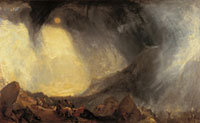Joseph Mallord William Turner
dal 30/9/2007 al 5/1/2008
Segnalato da
30/9/2007
Joseph Mallord William Turner
National Gallery of Art, Washington
Over the course of six decades, Turner transformed the genre of landscape through works that proclaimed him heir to the old masters even while they heralded a new and visionary direction in 19th-century painting. Known for his technical brilliance and startling use of light and color, he incorporated learned references to literature, mythology, and historical events in his pictures.

Retrospective
Rising from a modest background, Joseph Mallord William Turner (1775–1851) became the leading British artist of his era. Over the course of six decades, he transformed the genre of landscape through works that proclaimed him heir to the old masters even while they heralded a new and visionary direction in 19th-century painting.
Known for his technical brilliance and startling use of light and color, he incorporated learned references to literature, mythology, and historical events in his pictures. His commitment to the idea that watercolor equaled oil painting in complexity and expressive power raised the standard for others working in the medium. And his exquisitely rendered works, heralded for their virtuosity, inspired generations of artists.
This exhibition is the most comprehensive survey of Turner's work ever presented in the United States. More than 145 paintings and watercolors reveal the astonishing talent and imagination of this artist—whom Alfred, Lord Tennyson called "The Shakespeare of landscape."
National Gallery of Art
6th Street and Constitution Avenue - Washington



